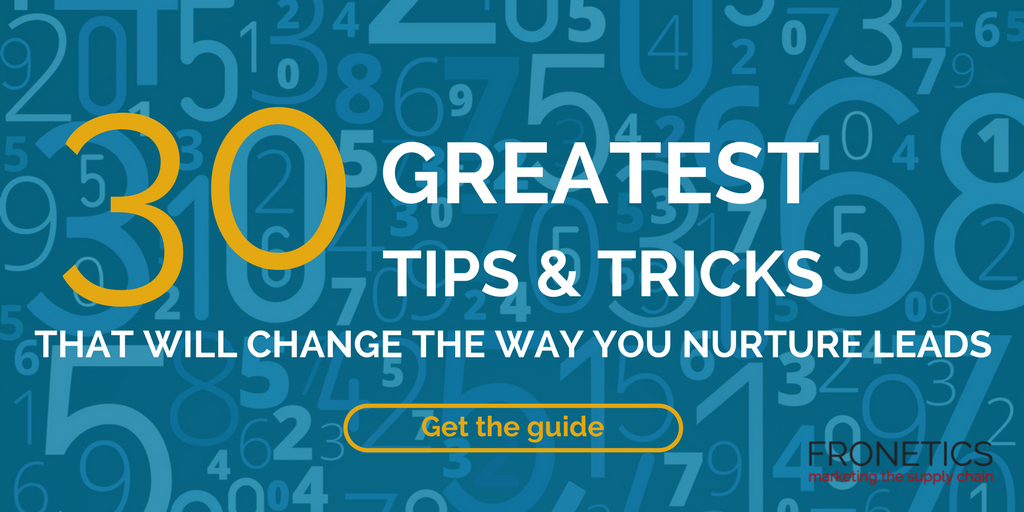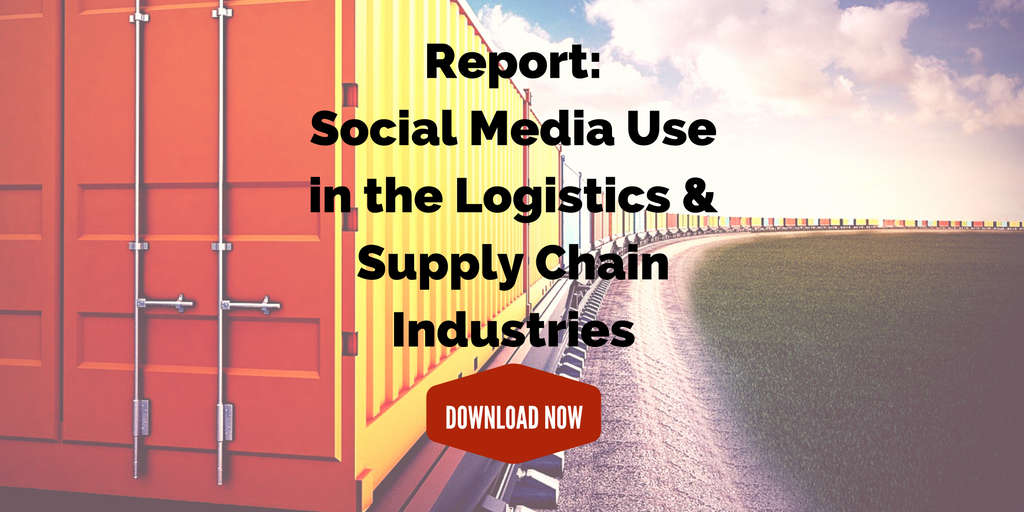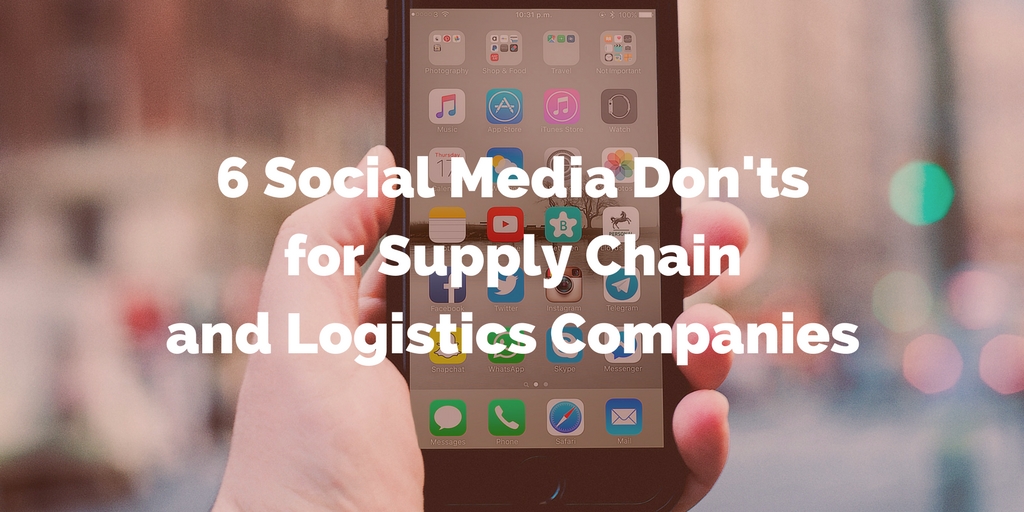
by Fronetics | Aug 31, 2017 | Blog, Marketing, Strategy, Supply Chain
As B2B buyers expect customized sales experiences, sellers can use these 3 tips to offer personalization at scale.
One of today’s biggest challenges facing B2B sellers is the increasing expectation of personalization as part of the buying experience. The seller’s task of offering personal experiences for all leads is a daunting one, particularly with limited time and marketing budgets.
As companies become increasingly focused on risk-mitigation in the buying process, they are far more inclined to trust vendors who can demonstrate that they understand and can address their specific needs and risk factors. According to Demand Gen Report’s 7th Annual B2B Buyer’s Survey, 89% of respondents stated that winning vendors “provided content that made it easier to show ROI and/or build a business case for the purchase.”
While the task of personalization may be daunting, it’s not impossible. And it’s certainly worth the effort. Here are three strategies your business can use to personalize sales pitches and make your marketing dollars work more efficiently.
3 ways to offer personalization at scale
1) Target smarter
We all know that social media platforms offer a wealth of demographic information. One of the most valuable insights it offers is intent signals: things like job changes, social posts, and hiring patterns, all of which can help your sales team identify the right time and strategy for reaching out to a potential buyer. You can use social media features built into the platforms themselves, like advanced filters and lead bots, to identify qualified leads.
Beyond identifying leads, smart targeting involves well-written and targeted online ads. According to Demand Gen’s report, “Online ads are shaping early behaviors and opinions of B2B buyers. 63% of respondents said they noticed ads from the solution provider they chose during the research phase.”
2) Demonstrate your understanding
Justin Shriber, vice president of marketing for LinkedIn sales and marketing solutions, reports that “80% of buyers don’t believe that the salespeople they deal with understand their business.” Most of this perception, Shriber says, is driven by the way salespeople converse with potential buyers. Using generic openers, and talking more than listening, reinforces this negative perception.
Set yourself apart by making sure that your opener lets the potential buyer know that you are paying attention to his/her particular needs and challenges. Make use of the information you’ve gleaned from social media to open the conversation by addressing a need or question the prospect has recently voiced.
3) Engage more closely
An important aspect of the personalization B2B buyers and consumers alike have come to expect is ongoing engagement. “When sales professionals are unable to provide ongoing value,” says Shriber, “the buyer feels no obligation to maintain a dialogue.” Continuing the conversation throughout the buying cycle is key to keeping the potential buyer invested. In addition, the most effective sellers use technology like email tracking and PointDrive to gauge whether the information they’re sharing is hitting the target. These technologies provide sales professionals with a feedback loop that they, in turn, can use to tailor future interactions.
Related posts:


by Fronetics | Aug 29, 2017 | Blog, Content Marketing, Current Events, Marketing, Social Media
When it comes to social media news in August 2017, the words of Kanye West, “stronger, better, faster, stronger,” have never been truer.
August has seen a continued push to get more information to more people in real time. Pinterest is introducing mobile ads. YouTube is adding sharing and chat features to the app. Google is developing new software to rival Snapchat. And, of course, the social media giant Facebook is always working on new improvements to dominate its competitors.
Facebook Tests Custom Audiences Based on Interactions with Event Pages
Brands will soon have the ability to create custom audience groups based on visitors’ interactions with the brand’s event pages. Facebook has confirmed that brands will be able to choose custom audiences made up of users who responded to any event on their pages or to specific events, and they will also be able to include users who RSVPed as going, interested, or both. Though only in its testing phase, these initial companies have been able to create audience groups based on interactions within the past 180 days.
Google Developing Rival to Snapchat Discover Feature
Back in 2016, Snapchat introduced ‘Discover,’ which allowed users to view news in the form of Snapchat Stories. At the time, this new technology allowed social media to combine news and television in short videos. Now Google wants a piece of the action. Google is working to allow publishers the ability to create media-oriented content. “The new publisher technology, called ‘Stamp,’ represents an escalation in the competition between tech platforms for publisher partnerships and access to media content, which they need to drive user engagement,” writes Erik Sass for Media Post.
Pinterest Rolls Out Mobile Video Ads to All Advertisers
Initially introduced a year ago to a limited amount of Pinterest advertisers, now all advertisers will have the ability to create mobile video ads. Using auto-play, the new type of promoted videos will begin playing as soon as users scroll across a brand’s feed and will also auto-play in Pinterest’s search results. Jenny Chiu, head of partnerships at Pinterest, said in a blog post, “Your Promoted Video sparks into action the moment a Pinner scrolls across it in their feed — no need to hit play. They can just sit back and watch your video unfold. And unlike on other platforms, where ads interrupt people as they’re trying to enjoy posts from friends, on Pinterest, people are actually looking for videos that inspire them to give ideas a try.”
Twitter Tests New Feature that Allows Brands to Automate Their Promotional Tweets
Twitter is in the initial testing of having brands pay ($99) to have their tweets automatically promoted on its app. Brands can tweet as they normally would, and the social network will automatically promote some of those tweets, but brands cannot customize which tweets are promoted. Twitter will create bi-weekly reports that will include information on audience insights, user growth and new user engagement. Companies were able to sign up on Twitter’s homepage to try to land a spot in the beta testing, which is now completely full. Stay tuned to see if Twitter rolls out this new feature to all users.
LinkedIn Rolls Out Quick Access to Samsung Users
LinkedIn and Samsung have teamed up to create the ultimate user experience. Now Samsung Galaxy S8 and S8+ owners can have access to LinkedIn’s content and calendar experience. Using Bixby, Samsung’s digital assistant, users can easily access LinkedIn’s Trending Storylines that include top news stories and scheduling details through My Schedule notifications.
YouTube Adds Chat and Sharing Features to Mobile App
YouTube has been working on ways to make sharing videos easier than ever. With the newest app features, users can share videos directly through the mobile app, as well as chat with other viewers in real time. YouTube announced on its blog, “Not only can you share and receive videos in the app, you can also chat about them right on YouTube, reply with another video, invite others to the conversation, and more. We think it’ll make sharing easier, faster and more fun on your phone. And if you want to continue sharing videos through other apps, you can still do that too.”
Related posts:


by Jennifer Hart Yim | Aug 24, 2017 | Blog, Content Marketing, Manufacturing & Distribution, Marketing, Supply Chain
Here are seven tips for manufacturers to improve your email marketing strategy in the manufacturing and industrial sector.
This post comes to us from Adam Robinson of Cerasis, a top freight logistics company and truckload freight broker.
Email marketing is a powerful tool for growing and developing different types of businesses. However, many industries are still unaware of the power of using an appropriate email marketing strategy. Many manufacturers and industrial companies are still stuck in the one-off batch and blast mode of email marketing. That strategy is not likely to work very well in industrial marketing, where most of the purchases are expensive; complex products with long sales cycles, multiple decision-makers, and stakeholders are involved; and there is a much higher risk if a wrong decision is made.
7 email marketing tips for manufacturers
1. Avoid SPAM at all costs
The last thing that you want is for your emails to end up in someone’s spam folder or have your emails banned from someone’s inbox. Before you even start an email marketing campaign, you should print out the latest copy of the CAN-SPAM act to remind yourself of some email marketing principles, such as any recipient must have given their consent before receiving commercial email, have an option to unsubscribe from receiving further emails, do not mislead the recipient about the content or the origin of the email, and use approved methods to get a recipient’s email address.
2. Personalize your emails
You should avoid sending generic emails. Your recipients are not all the same, and you should make distinctions between them by segmenting your database. This means sending the same type of email diversified in some key aspects depending on the type of recipient. The content and filters of platforms such as Litmus and Reach Mail, which is based on personal data, geography, activity, and devices used, let you automate the entire process to narrow your focus and identify the ideal sub-section of your list.
3. Increase your traffic and clicks
By creating the perfect email marketing campaign, you will have the power to turn emails into clicks and traffic to your website. Sending relevant links to your subscribers will drive them to your website, and this increases the potential for new sales. If you want to give a real boost to your click-thru rates, you should keep in mind that you have to get rid of the clutter. Having an email that has too many graphics and banners will confuse your readers and leave them wondering what they are supposed to click on.
4. Offer quality content
You should always provide useful, quality content in an email and links to further information. Your emails should be more informative than sales-related, especially in the manufacturing industry. Talk about your company’s safety standards, advertise interviews with experts, and discuss pressing matters in your industry. Not presenting your information in a clear and accurate way will put off your recipients. You can take advantage of online tools to help you with your content writing. Use Australian Help and Oxessays as copywriting tools for writing your emails and Bigassignments to help you to edit your content. [Editor’s note: You can also partner with a third-party marketing firm to develop and execute an email marketing strategy for your business.]
5. Optimize your subscriber list
Do not rush out and buy an email list to get started with email marketing. You should grow your in-house subscriber list and get to know your customers and what they need from you.
6. Link your email platform with other channels
Email platforms, external databases, e-commerce, social media, and business intelligence systems can all be linked to optimize your business and reach more potential clients. Platforms such as Mail Chimp and Mad Mimi allow you to connect and integrate every system, synchronize the information on each, and have them communicate with each other.
7. Automation and tracking
You should try to make your email marketing strategy as efficient as possible with email marketing automation. Platforms such as the mentioned Litmus and Reach Mail will let you automate the entire process. Analyzing and tracking your campaigns’ performance is also essential. Using the analysis tools and reports available from the platforms we suggested will allow you to check and optimize your clicks, traffic, and sales.
Wrapping up the 7 email tips for manufacturers
There are many things to consider when creating an email marketing campaign. The main goal is to effectively connect with potential customers to persuade them to purchase your product by reminding them that you exist and that you are helping. Use these email tips for manufacturers to continually improve your sales and grow your industrial business.
Related posts:


by Fronetics | Aug 23, 2017 | Blog, Content Marketing, Marketing, Social Media
In keeping with social media etiquette for businesses, you really shouldn’t do these things.
It’s easy to get bombarded with suggestions on how to interact with your customer base on social media. Amid the endless barrage of ideas for what to do, it’s worth remembering that not all social media engagement is equal — sometimes, it’s just as important to remember what not to do. (See for example #LeggingsGate.)
Let’s talk about the specifics of keeping your proverbial foot out of your business’ mouth online. Take a look at the list below of 6 don’ts for B2B businesses.
6 social media don’ts
1) Don’t assume that just because you’re online, offline rules of communication and conduct don’t apply.
It may seem obvious, but it’s all-too-often forgotten. This is a good rule, and an easy metric by which to judge any content before posting: Your interactions online should measure up to professional interactions you would have in person.
2) Don’t re-post, re-tweet, re-gram, or re-share external content without a thorough check first.
Re-posting content that’s of interest to your business’ audience is a great way to promote discussion and engagement. But don’t get sloppy. Remember that even if content didn’t start with you, if it’s posted on your company’s social media accounts, it represents your business. Make sure content is well-researched and from reliable sources. Want to re-post something controversial? Just be sure to include a disclaimer or explanation in your post.
3) Don’t forget that emotional intelligence is just as important for businesses as for individuals.
Never forget that behind every social media account is a human being. The bottom line: “bring emotional intelligence to your social media management. Take the time to address any issues with compassion and understanding.”
4) Don’t ignore comments.
Social media is all about engagement with your audience and potential customer base. Yes, responding to every comment takes time and resources, but it is well worth the effort. A comment ignored sends the message that you don’t feel that your customer’s question, concern, or observation is important. Use comments as the opportunity they are to interact with your followers, and show them that you are ready and willing to address any issues they may have.
5) Don’t delete negative comments.
Once it’s online, trust that people have seen it. Deleting a complaint will only make your business appear insensitive and evasive. Addressing negative comments demonstrates that your company is proactive about resolving issues and taking care of your customers.
6) Don’t forget the basic principals of common sense and good judgment.
This one comes from John P. David of David PR Group. It seems like another obvious one, but people and businesses violate this principle all the time. Always have at least two pairs of eyes on everything you are going to post, and anything remotely controversial should be thoroughly vetted by as many people as necessary. When in doubt, David says, don’t post.
If your company has committed any of these social media don’ts in the past, don’t panic. These platforms offer an ideal place for renewing and tweaking your image. Invest in the creation of a good social media policy. Don’t give the enormously important task of social media management to a summer intern. And, for goodness’ sakes, remember you’re a human talking to other humans.
Related posts:


by Fronetics | Aug 22, 2017 | Blog, Content Marketing, Logistics, Marketing, Supply Chain
Supply chain and logistics businesses need to be about more than themselves, and content marketing can help them get there.
While conventional wisdom tells us that content marketing is useful and important for any business, there are still some in the supply chain and logistics industries that remain unconvinced. It’s an understandable conundrum: Content marketing requires significant time, labor, and resources, and it can take quite some time to start reaping benefits.
The bottom line is that studies have shown that of companies with a documented content marketing strategy, 86% find their efforts to be successful in generating new leads, creating lasting relationships with customers, and increased ROI.
How can content marketing make my business better?
Consider this: Content marketing helps a company become more than just another business to customers — it can become a valuable resource for everything related to their products and services.
A good content marketing strategy is about understanding the questions and concerns that are particular to your customer base, and offering quality information and analysis that answers those needs. In the words of River Pools & Spas co-owner Marcus Sheridan, “The moment we stopped saying, ‘We’re pool builders,’ and started saying, ‘We are the best teachers in the world about Fiberglass pools and we just happen to install them as well,’…that was one of the most prosperous days of our lives.”
It’s worth noting that Sheridan was discussing his company’s turnaround from near bankruptcy to becoming a global leader in its field. He attributes this success to switching his company’s mission from selling its product to educating potential buyers — namely, content marketing.
Your business is more than its product.
Recognizing that your business has more to offer than its primary product or service is at the core of what content marketing is all about. Kirk Cheyfitz, CEO of Story Worldwide, puts it this way: “Like a decent human being, brands need to be about more than themselves.”
Start thinking about your business this way. You have a team of people with a tremendous aggregate of experience, expertise, and perspectives. That means that you can offer your audience far more than simply your primary product or service: You can offer them knowledge. Your audience is, in turn, far more likely to become buyers as you provide value — which builds trust and cultivates lasting, fruitful relationships.
What can I do to implement an effective content marketing strategy?
If you’re just jumping on the content marketing bandwagon, it’s an exciting time for your business. You might want to check out our Twelve-Step Guide to a Content Marketing Strategy and other resources to help you through the process.
A visual content audit is a solid first step. The main thing to keep in mind is that you have valuable resources at your disposal that you can offer your audience of potential buyers — start sharing!
Related posts:


by Fronetics | Jul 27, 2017 | Blog, Content Marketing, Current Events, Marketing, Social Media
In July’s social media news, platforms saw a rise in daily active users and broke records in more than one category.
Once thought to be a passing trend, social media is nowhere near slowing down in terms of growth. Next Web reported that India has taken over as the largest audience of Facebook, beating out the U.S. with over 241 million active users. Active users in India are up 27% in the past six months, twice the rate of U.S. users.
But the social media news doesn’t stop there. Facebook and Instagram are topping charts with their active users. LinkedIn and Google are boosting job opportunities through new features and search capabilities. And social media monitoring platforms are adding video to their repertoire.
Here’s a look at this month’s social media news.
Facebook reaches over 2 billion monthly active users around the world
India isn’t the only country boosting Facebook user numbers. The social media giant just celebrated having “2 billion people connecting and building communities on Facebook every month.” The company thanked its users with a personalized video and Mark Zuckerberg’s promise to take the global connection and use it to create a “more open and connected” world.
Instagram Stories reaches 250 million daily active users and adds live video replay
Instagram Stories continues to take over the ‘stories’ arena with 250 million active daily users. Snapchat, which founded the stories format, is falling far behind with only 161 million active daily users. Instagram Stories was unveiled last August and has experienced remarkable growth and success thanks to support from its sister company, Facebook. The social media platform has also introduced its newest feature, a share button with the ability to replay live videos for up to 24 hours.
Facebook tests custom audiences based on engagement with Instagram Business Profiles
Adweek reports that “Facebook is testing the ability for brands to create custom audiences based on engagement with Instagram business profiles.” This new type of filtering could allow brands to create engagement audiences, people who have previously engaged with your content on Instagram. Filters could include all interactions, users that have commented on a post, or any activity within a certain time frame. Though only in the testing stages, these custom audiences could help brands create specific messaging for targeted audiences based on their interactions with a brand’s Instagram page.
CrowdTangle adds video views to metrics
CrowdTangle, a social media monitoring platform for brands, has just added video views to its metrics for Facebook and Instagram. With video’s increasing popularity, the company felt it was important to offer its clients a way to measure how their videos are performing. “Publishers can now easily track emerging new trends and best practices on Facebook and Instagram, as well as discover great videos and video creators, see overall video views across their industry, and benchmark themselves against competitors,” CrowdTangle says.
LinkedIn creates new search to boost job opportunities
LinkedIn has created new search capabilities that make it easier for users to uncover new jobs and other professional opportunities. The new search also allows users to see the companies and job titles of the people who found them in a search, identifying opportunities that align with the user’s resume. Available on your phone or desktop computer, these new features make searching jobs and hiring managers that much more accessible.
Google launches Google for Jobs
Partnering with the biggest job searching sites — like LinkedIn, Monster and CareerBuilder — Google just introduced a new initiative to allow users to find job opportunities directly through a Google search. The new search update also allows users to receive email alerts of new employment postings in real time. “When Google for Jobs launches, it will act as kind of a mega job-search engine that will let you sort through multiple career sites in one go,” says Google CEO Sundar Pichai.
Related Posts












